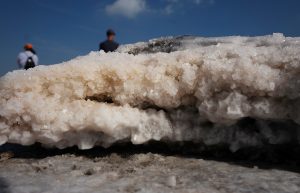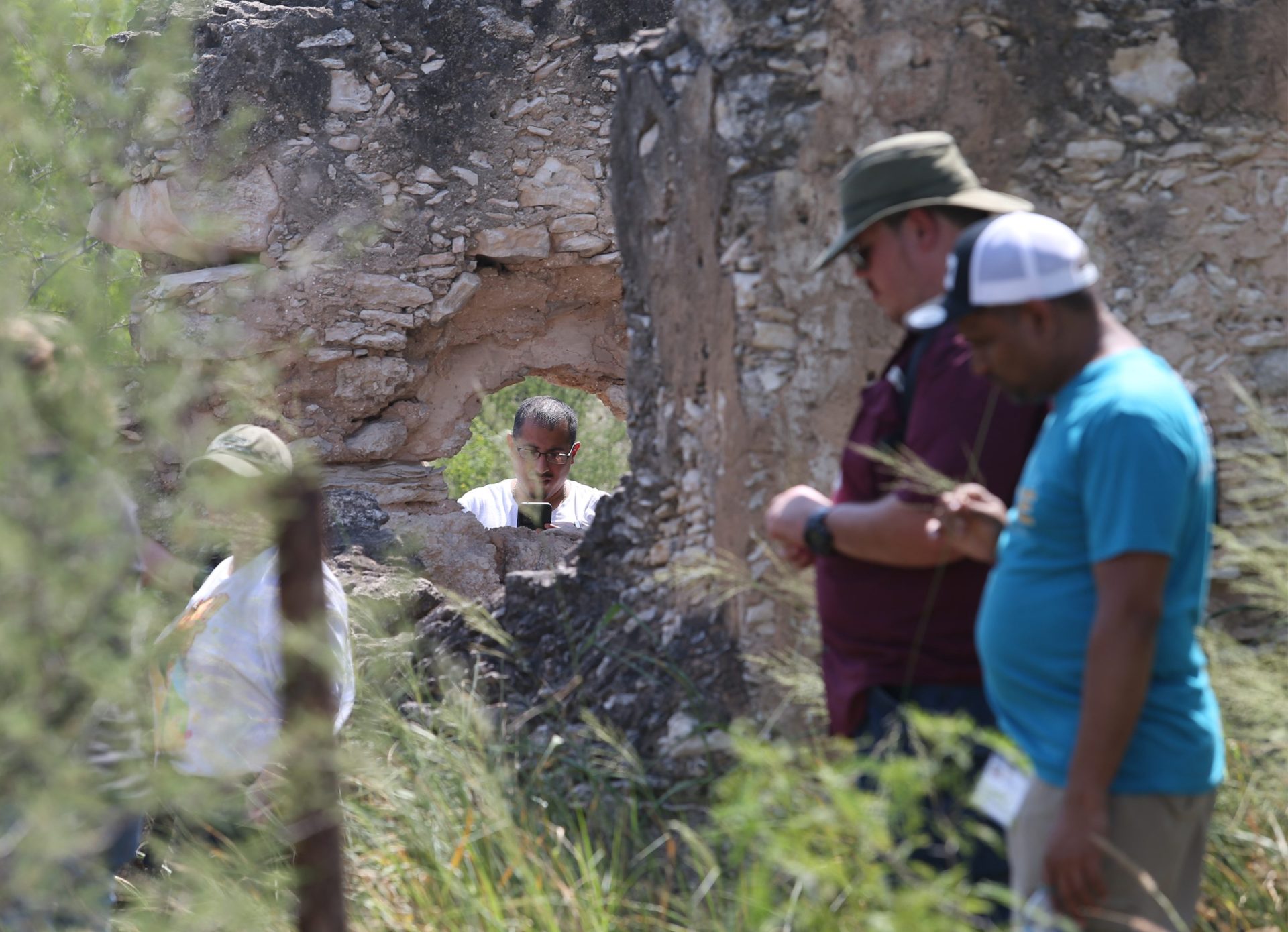|
Only have a minute? Listen instead
Getting your Trinity Audio player ready...
|

NEAR LINN — A charter bus dropped off a gaggle of teachers and college intellectuals at the Lower Rio Grande Valley National Wildlife Refuge Friday morning, leaving them to amble off down the caliche path to see La Sal Del Rey.
It was, even relatively early in the morning, already brutally hot. There was some question about whether the salt lake would actually be a lake, like it was the week before, or whether it would have dried out into a 500-acre patch of salt crust.
Either way, the UTRGV experts on hand said, the excursion presented a valuable opportunity for the 45 educators from six local school districts and one college who joined them Friday.
The trips, and an identical one the week before, are a new addition to the university’s Ancient Landscapes of South Texas professional development initiative, which for the second year running will teach over 125 Valley educators how to incorporate local cultural and natural history into their classroom coursework.
“The teachers are learning about the very unique history of the Rio Grande Valley of Texas that dates back 43 million years,” said Roseann Bacha-Garza, an anthropology lecturer and manager of the university’s Community Historical Archaeology Project with Schools program. “And we are bringing to light this unique geological, natural and cultural part of our landscape that they can intern teach in the classroom with TEKS-aligned lesson plans.”
Sal Del Rey was the first stop for the group in a whirlwind tour of some of Hidalgo and Starr counties’ more notable geological and historic sites, which include things like volcanic ash deposits near Rio Grande City and San Isidro’s 18th century hand-dug water wells.
It’s the kind of stuff you’d drive by with little more than a curious glance. The kind of things that lack visitor centers and any real way to understand without taking out your phone and poking around on the internet.
Even Sal Del Rey — perhaps the Valley’s most notable natural feature — has only a couple signs to explain the lake to guests.
The teachers and their university counterparts passed one of those signs and emerged from the brush Friday to find the salt lake was, in fact, still a lake.
They milled around on the crunchy salt bank. One of the UTRGV professors bent down to pick up a pinch of salt, which he tasted and evidently liked — he contended it would taste good on pizza.

If many teachers were bold enough to follow suit, they apparently did so more discreetly.
The UTRGV experts — interdisciplinary scholars from a variety of backgrounds — started talking to the group about the lake, about how it was used by the Native Americans and by the Spaniards and by the Confederates, about why animals still rely on it today.
They fielded questions from the teachers.
Why did the lake have a distinct reddish hue Friday? A byproduct of the brine shrimp that live in it, one of the university folks said.
Does anything live in the lake? Not much, save the brine shrimp, though a good deal of animals live near it.
Visible to one visitor on the road to and from the lake Friday: a lone cow nilgai, two road runners and a 5- to 6-foot indigo snake that about 30 teachers strolled past without noticing.
Laura Rodriguez, who teaches history and geography at South Texas ISD Health Professions in Mercedes, had visited Sal Del Rey before, but not in the company of university experts. She said it was valuable.
“It’s one thing to see it in a textbook and for you to explain it, but it’s another thing to experience it,” Rodriguez said.
The Ancient Landscapes program aims to help K-12 teachers bring that kind of experience to their students. Participants will get a kit outfitted with supplies like a recreation atlatl, a bit of petrified wood silicified in volcanic ash and a salt sample from Sal Del Rey (taken with special permission).
The goal, CHAPS Director and Associate Dean for Faculty Research Russell Skowronek said, is to expose Valley students to fascinating local history that’s practically in their backyard, but poorly understood.

“Not only do we not recognize it as residents of the region, but it is totally unknown to residents of Texas and the country,” he said. “But they’re gonna be some of the first ones to have an education that no one else is getting anywhere in the country that’s integrating earth and natural sciences like this.”
Bacha-Garza and Skowronek agree that the Valley’s cultural and natural history is not particularly well known, locally or elsewhere.
Skowronek notes that not as many folks work outdoors as once did, and suspects that plays a role. Bacha-Garza, perhaps reflecting on Friday’s particularly toasty expedition, thinks the heat may dissuade people from capitalizing on the area’s natural resources.
Both agree that the geology and history they demonstrated to teachers Friday isn’t the type of thing that squares neatly with the narrative of your average school textbook.
Skowronek tends to get excited about talking about ongoing CHAPS projects, and conversations can sometimes turn into a dizzying list of initiatives that don’t at first seem to be directly connected.
There’s the immersive poster on projectile points he says has received international attention. A coffee table book that describes the places Friday’s tour visited. Trail guides, podcasts, the Rio Grande Valley Civil War Trail, a documentary film set to premiere in November.
The common thread between projects that cover millions of acres and over 4.5 billion years of history is that they’re designed to be readily accessible and understandable.
Valley history may be poorly understood now, but it will not remain so if people use those CHAPS resources, which Skowronek and Bacha-Garza describe the Ancient Landscapes professional development as being an important part of.
“Their students are going to learn how unique and special this Rio Grande Valley of Texas is,” Bacha-Garza said. “And that is what we hope gives them a sense of community pride. So they stand up a little taller and prouder and are excited about where they live, and want to go home and talk to their parents and grandparents about what they’ve learned in the classroom that day. If we increase the sense of community pride in our children, in our region, then we’ve done our jobs.”
To see more, view Monitor photojournalist Delcia Lopez’s full photo gallery here:
Photo Gallery: UTRGV program makes local history, culture accessible to teachers



